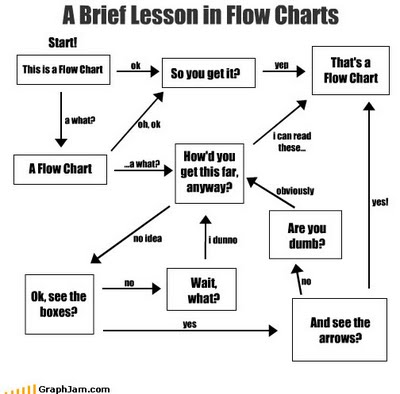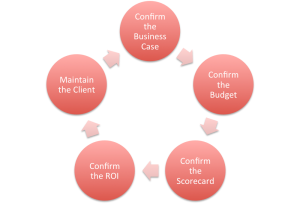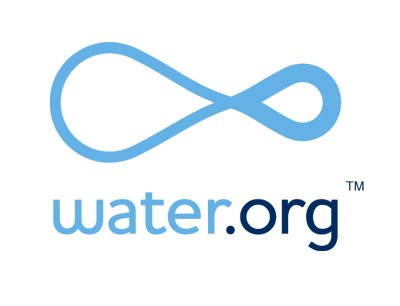 How many sales seminars have you been to that involved a lengthy or complicated sales procedure? Or perhaps they had a canned presentation with a general methodology that worked in their industry back in the days when they were carrying a bag? Too many, I’m betting. You’ve seen all kinds, from spreadsheet-intensive flow charts that require you to fill in all the blanks with names and titles whether they are pertinent or not, all the way to complex wall size documents that could have been used as a planning guide for the invasion of Normandy.
How many sales seminars have you been to that involved a lengthy or complicated sales procedure? Or perhaps they had a canned presentation with a general methodology that worked in their industry back in the days when they were carrying a bag? Too many, I’m betting. You’ve seen all kinds, from spreadsheet-intensive flow charts that require you to fill in all the blanks with names and titles whether they are pertinent or not, all the way to complex wall size documents that could have been used as a planning guide for the invasion of Normandy.
The problem? One size does not fit all. In fact, one size does not even fit one.
The reason is that every industry is different, with a unique sales cycle complicated by a multitude of factors. If you consider the individual nature of your prospect and the other people who will be a part of the decision, add the complexities of your own company plus your own sales style, it is easy to see why these overly complicated “fill in the blank” template sales seminars rarely have any lasting impact on salespeople. While they may make sense on paper, they become more of a hindrance than a help after just the first few minutes of your sales call (“Slow down Mr. Customer, I’m still filling in the blanks”).
After slinging all these arrows at sales processes, am I really going to offer you my own sales flowchart procedure? Yes, but I promise it won’t hurt. Much. It doesn’t fit into a nice format having exactly 10 steps or have the first letter in each step spell out a word. It would be great if the sales process was that predictable and linear, but so far, I’ve never seen that happen. At Client Centric Sales, there are ultimately only five phases:
 Confirm the Business Case
Confirm the Business Case- Confirm the Budget
- Confirm the Scorecard
- Confirm the ROI
- Maintain the Client
It would be great if the last one was “Confirm the Client” so I could call this my “5 C’s Sales Program,” but then I would be as guilty as anyone else who was putting out a mnemonically titled program. You could argue that “Qualify the Prospect” should be added in there somewhere. But as regular readers of Client Centric Sales know, qualifying is done continuously within each of these steps. We will cover the above in more detail in coming chapters, but for now let me explain each a bit so that they make a bit more sense as we move forward:
Confirm the Business Case – We need to mutually examine the problems to be solved, agree on terms, eliminate assumptions, and verify that a solution exists. We must also understand the impact that our solution will have on the business, both positive and negative.
Confirm the Budget – We need to verify that there is a budget approved for the amount that is required for our proposed solution. It is also important that we align ourselves with our prospect’s expectation of not only the financial side of the budget, but also the time and people who will be required from both sides.
Confirm the Scorecard – There are many parts to the scorecard. We need to not only confirm that the person we are talking with is a decision maker, but we also need to verify who, if any, the other decision makers are. At this point we should have mutually created a scorecard that will be used to clarify what problems the product or service will solve, how it will solve them, whom it will impact, and how the purchase decision will be made.
Confirm the ROI – Here we finalize the business case with data gathered by our prospect and by our company. This data will be used to confirm in great detail how our product or service meets or exceeds the solution required for the prospect. This step is often the creation of a formal proposal or presentation, and it will summarize the data gathered in the first three steps.
Maintain the Client – Whether you won the sale or not will affect your future relationship with the prospect. If you were awarded the sale, it is only the first half of the relationship. Over the next five years, a well-maintained client relationship can produce additional revenue equal or greater to the original sale. If you were not awarded the sale, that doesn’t mean your engagement with this prospect should end with a slammed door.
We have covered all of the above in Chapters 1-14. Next we will spend more time getting into the detail of each of these steps.
Will the Client Centric Sales method work for all sales situations? Obviously, the answer is no. The depth of engagement that I am asking from you is best served when dealing with large, complex, or highly technical sales. And if you take the lessons we will be discussing in coming chapters as a guide, and then add the particulars of your personality, your company, your prospect, and your industry, then you can use these five simple steps to develop your own unique sales process that fits you perfectly.



